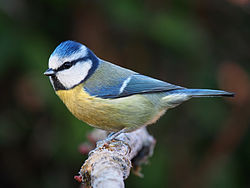| Cyanistes | |
|---|---|
 | |
| Eurasian blue tit (Cyanistes caeruleus) | |
| Scientific classification | |
| Kingdom: | Animalia |
| Phylum: | Chordata |
| Class: | Aves |
| Order: | Passeriformes |
| Family: | Paridae |
| Genus: | Cyanistes Kaup, 1829 |
| Type species | |
| Parus caeruleus Linnaeus, 1758 | |
| Species | |
C. caeruleus | |
Cyanistes is a genus of birds in the tit family Paridae. The genus was at one time considered as a subgenus of Parus. In 2005 an article describing a molecular phylogenetic study that had examined mitochondrial DNA sequences from members of the tit family, proposed that a number of subgenera including Cyanistes be elevated to genus status. [1] This proposal was accepted by the International Ornithologists' Union [2] and the British Ornithologists' Union. [3]


